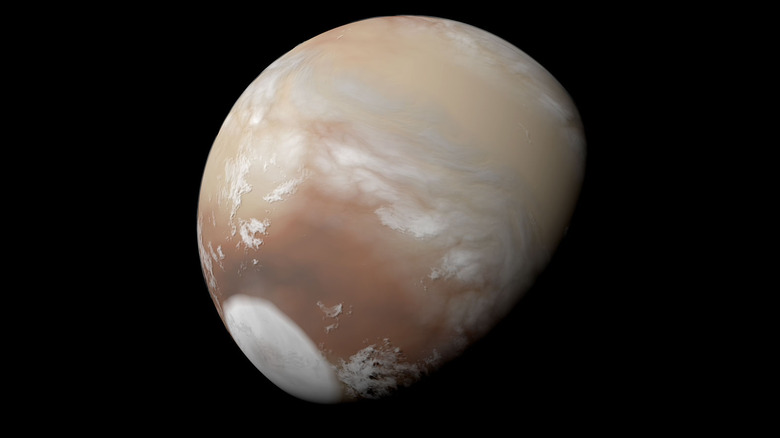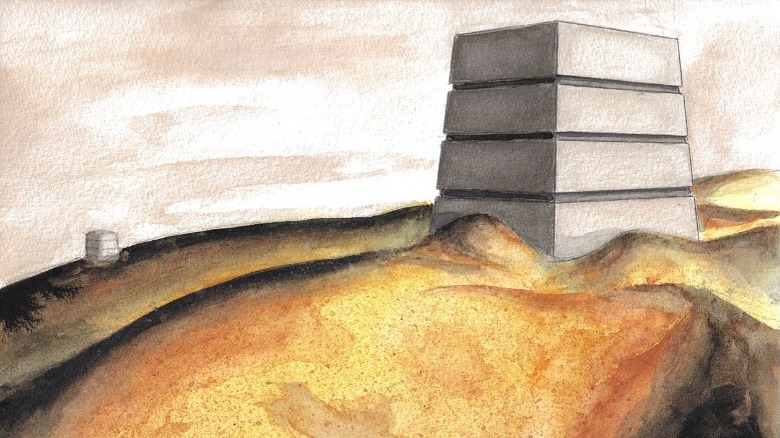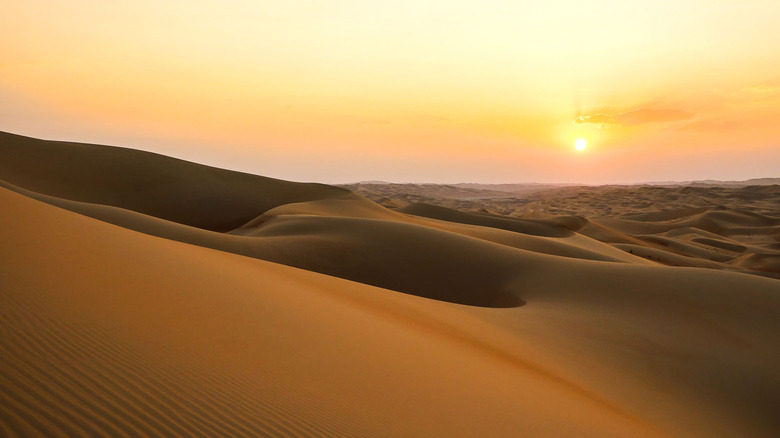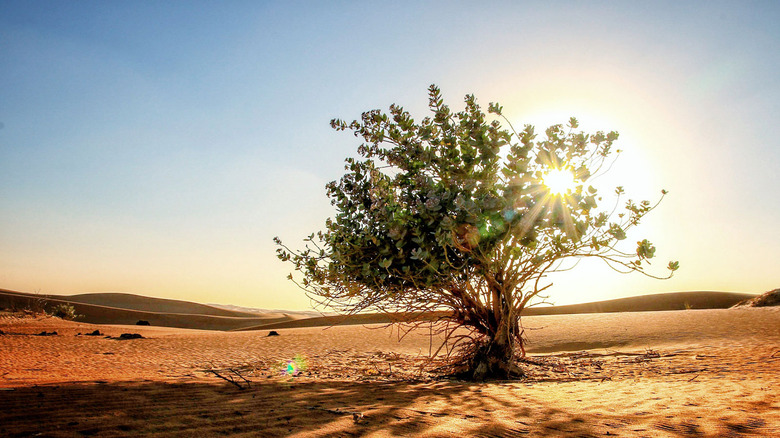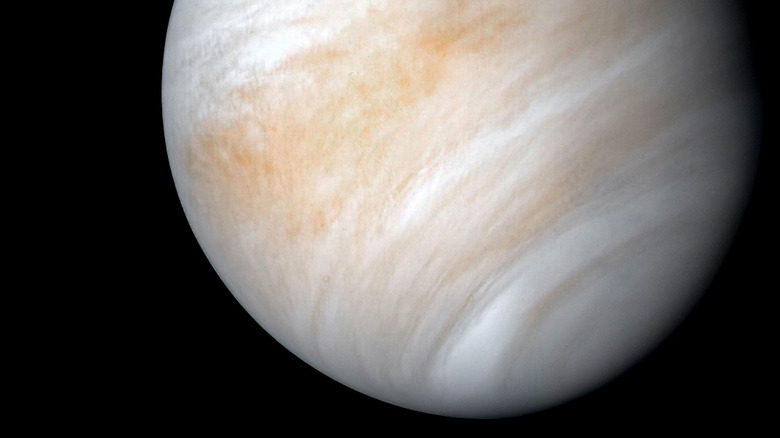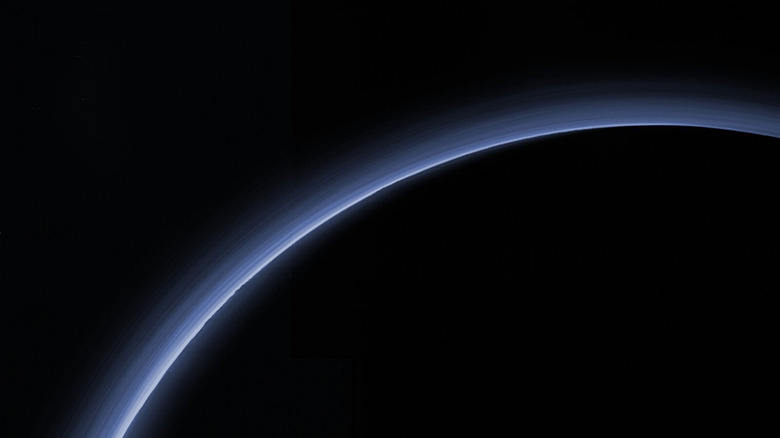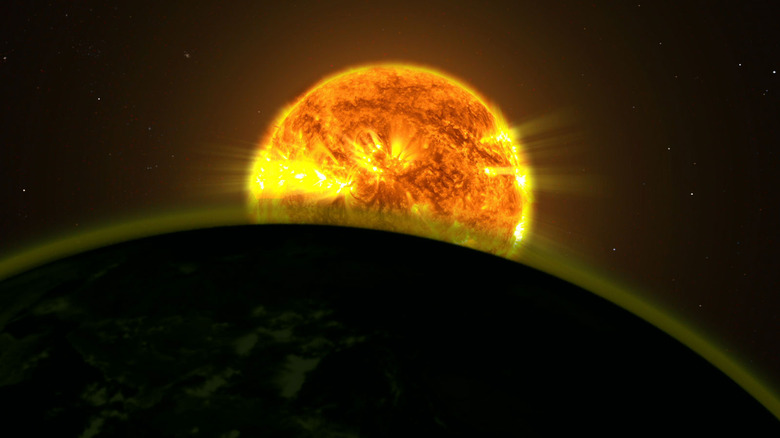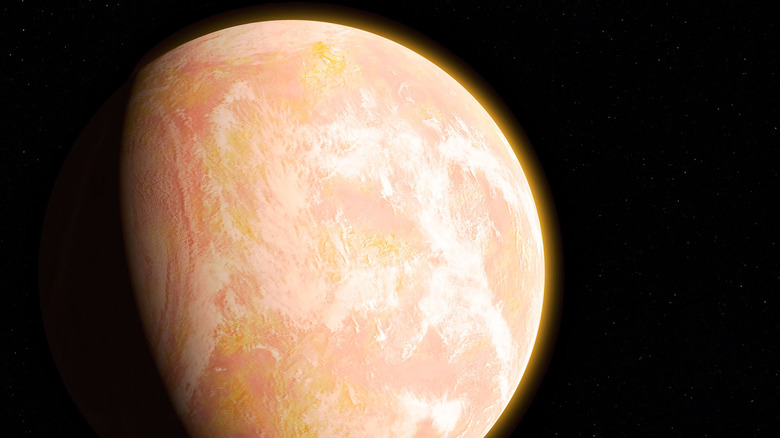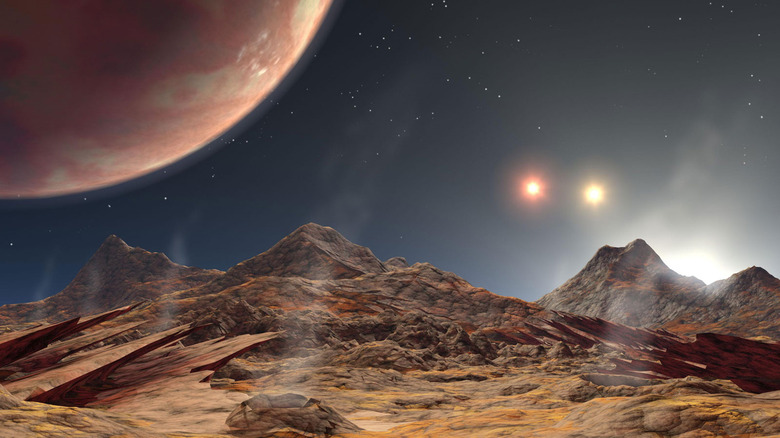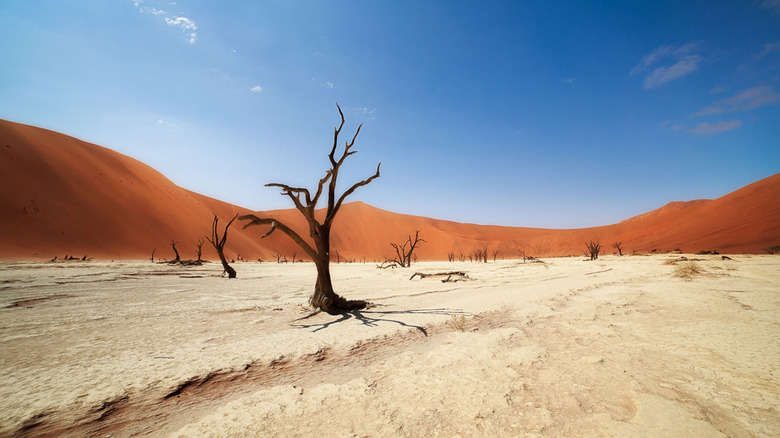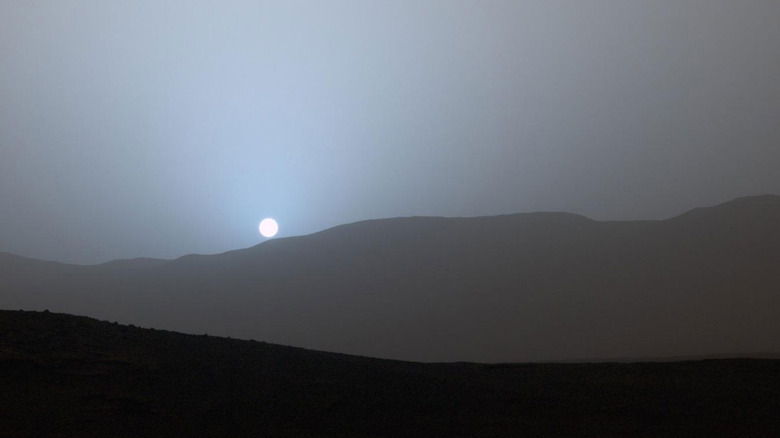The Truth About Desert Planets
One of the best-known planets in "Star Wars" is Tatooine, a harsh desert world with twin suns and endless rolling dunes, and the homeworld of Anakin Skywalker. To many people, it's easily the most familiar desert planet in science fiction, but it stands among a variety of other fictional worlds full of course, rough sand. The idea of the desert world as a science fiction setting is a compelling one and, interestingly enough, it may even be a more realistic setting than it first appears.
There's a genuine possibility that desert planets could exist in our galaxy, and some scientists have seriously considered where to find them, and what they might be like. One study, published in The Astrophysical Journal, analyses this idea in detail, finding that hot desert planets orbiting other stars may be able to sustain life.
Planets like these would be the same size as Earth, but closer to their parent star. These sun-parched worlds would be arid but livable, much like Tatooine in "Star Wars." NASA Exoplanet Exploration mentions that some astrobiologists find this idea every bit as compelling as science fiction writers do. Some climatologists expect that desert planets may even be abundant in the galaxy. The Milky Way galaxy might be sprinkled with planets like Tatooine and, surprisingly enough, their lack of water might be exactly what helps them to remain habitable.
Desert planets in fiction
In 2021, Denis Villeneuve brought the world of "Dune" to life on the big screen. The movie's cinematography places indulgent emphasis on the strange, hostile beauty of the planet Arrakis (pictured, artist interpretation), with its vast expanses of desert landscape. Arguably, "Dune" is directly responsible for the popularity of desert planets in science fiction. As a prominent example, The Guardian notes the influence of Frank Herbert's Arrakis on George Lucas's Tatooine: the original introduction to the entire "Star Wars" universe, and most recently the setting for the new series "Obi-Wan Kenobi," a story about a once-great hero, now an outcast in an entire world of barren sand. The concept alone is evocative.
An article at Tor.com discusses the appeal of desert worlds in fiction. At least for most Western audiences, a desert is an entirely unfamiliar environment. The unusual landforms. The strange lack of noise. The dryness and intensely starry night skies. As such striking environments, deserts are a staple of both science fiction and fantasy. An article at Book Riot talks about this, noting the range of fiction inspired at least partially by both the geography and cultures of Africa, Asia, and the Middle East. While authors do, of course, need to be wary of avoiding harmful orientalist tropes when writing works like these, there's nonetheless a charm to these settings which can't be found elsewhere. This makes the prospect of discovering real-life desert planets orbiting other stars all the more inspiring.
The climate of Arrakis
The planet Arrakis, from Frank Herbert's "Dune," is a scorching hot world. Humans can live there, but the careless will quickly perish. Those who live there do so by cultivating an intimate knowledge of how to survive. It's such a compelling idea that, following the release of Villeneuve's movie adaptation in 2021, a group of climate scientists decided to model the world of Arrakis to see whether such a place really could exist.
While not a formal scientific study, an article in The Conversation discusses whether humans really could survive the climate of a planet like Arrakis, including a full climate model for Arrakis – the same kind used by meteorologists to predict weather here on Earth. Arrakis may be a fictional world, but there are plenty of written details about the kind of place it is. This model draws from these, accounting for things like the planet's orbit and atmospheric composition. Notably, while Arrakis has less carbon dioxide in its air, it contains much more ozone than Earth. Small points like these can make a huge difference. Ozone is a more powerful greenhouse gas than carbon dioxide.
The verdict, in a nutshell, is that much of Arrakis would certainly be habitable, while also being every bit as inhospitable as Herbert's original story shows. Surprisingly, the planet's mid-latitudes would be far hotter than the planet's equatorial regions. With more moisture in the air, these areas would trap more heat. On a desert world, water becomes deadly.
Life-sustaining desert worlds
Astronomers hoping to find evidence of alien life usually look for planets within their parent star's habitable zone, the region where a planet receives just the right amount of light for liquid water to pool on its surface. The idea of hot desert planets, however, can considerably expand the size of this zone, meaning the galaxy may contain many more habitable planets than most estimates imply. As a study in The Astrophysical Journal found, a desert planet orbiting a star like the Sun could theoretically remain habitable in orbits as close as 0.38 AU – as close as the baking hot planet Mercury.
Being dry is key to the habitability of worlds like these. A detail that Astrobiology Web highlights is that atmospheric water vapor is a potent greenhouse gas. The humidity of a hot world becomes vital to its habitability. Too much water vapor and the whole planet will cook. Too little, and carbon dioxide will accumulate, so the planet will also cook. The magic number, seemingly, is a humidity of around 1%. This is drier than the Sahara. Another paper, published in Geophysical Research – Planets, focused on the effect of the land itself, finding that planets with more land area can remain habitable closer to stars. Bare land, like sand and rock, is far more effective at radiating away any excess heat. This, as Live Science notes, is why deserts get so cold at night.
Ancient Venus
An interesting side to studies on desert planets is that they suggest Venus may have once been a habitable desert world. At least, it's possible. Sadly, there's no way to know for sure. The closest planet to Earth, Venus is a broiling pressure cooker of a planet, with a dense atmosphere of carbon dioxide trapping enough heat that its surface is hot enough to melt lead. But it wasn't always this way. As an article in Space.com notes, Venus may have been a habitable desert world around 1 billion years ago.
Venus is usually considered to be at the inner edge of the habitable zone, and its current intense heat is the result of a runaway greenhouse effect. However, most planetary scientists believe that Venus once had water oceans, not unlike Earth. A NASA article talks about this in more detail, explaining how, when they were younger worlds, Earth and Venus probably appeared very similar. No one really knows the exact reasons why Venus ended up the way it currently is. As Astrobiology Web notes, humidity can make a big difference to the habitability of a planet. It's possible that, if Venus had been drier in its distant past, it may still have been a hot but habitable desert world today. In a sense, the Venus we know isn't too different from a desert planet, extremely dry and with barely a whisper of water in its atmosphere, and even a few dunes, as an article in Icarus notes.
Losing water into space
The environment of any planet is far from fixed. Gradually, over time, a planet's surface and atmosphere will evolve and change. A major way this happens is that light gasses can be slowly lost into space. As explained by a paper published in Proceedings of the Royal Society A, this includes water vapor. A process called atmospheric escape slowly shapes a planet's climate, as light gasses slowly drift away into space. A planet can slowly lose water this way, gradually drying out.
An article from Scientific American talks about this in detail, mentioning how, in a planet's upper atmosphere, it's all about escape velocity. Just like a rocket traveling to orbit, if a molecule is moving fast enough with nothing in its way, it'll simply escape from a planet's atmosphere. This is even more likely if a molecule gets split into its much lighter component atoms.
Atmospheric escape can happen on any planet with an atmosphere, though it's easier with lighter gasses. As Popular Science notes, Earth's gravity isn't strong enough to hold onto helium, among the lightest gasses to exist, so any helium in Earth's atmosphere will inevitably be lost to space. A paper published in Annual Reviews of Earth and Planetary Sciences explains how astronomers have observed atmospheric escape happening in exoplanets too. Notably, it's a significant process in smaller planets, like Earth or Mars, with a major effect on how a planet evolves over time.
Atmospheric erosion
There's another way in which planets can lose water to space, known as stellar wind erosion. All stars constantly stream off a thin wind of particles, which can slowly grind away at a planet's atmosphere, known as a stellar wind (or, in the case of the Sun, the solar wind). As a science article from ESA explains, this is probably one of the main reasons why Venus lost its water. Unlike Earth, Venus doesn't generate its own magnetic field. Where Earth is protected from the solar wind, Venus has no such luck, taking the full force of the Sun's wrath. As the solar wind hits the upper atmosphere of Venus, it constantly strips it off, carrying away a stream of Venusian atmosphere into interplanetary space.
Planets around other stars may be dried out even faster by this atmospheric erosion, particularly with more active host stars. A paper in The Astrophysical Journal focuses on this, explaining how a planet can start to desiccate surprisingly quickly this way. The Sun is constantly roiling with flares and coronal mass ejections, which blast its orbiting planets with X-rays and ultraviolet, but some other stars can do this far more violently. Planets orbiting such active stars can lose huge amounts of water to space, as molecules in their atmospheres are torn apart by stellar radiation.
Hot exoplanets
The habitable zone around a star is sometimes known as a "Goldilocks Zone," as NASA explains. The place where an orbiting planet is far enough from a star to be not too hot, not too cold, but just right. Astrobiologists are most interested in planets orbiting in this region because this is where the only known example of life in the whole universe — the Earth — orbits. Astronomers have now found over 5,000 planets in orbit around other stars, according to the NASA Exoplanet Archive, but only a handful of these are comfortably inside the habitable zone.
The Arecibo Observatory currently lists just 59 known planets within the habitable zones of their host stars, but there are evidently many more known planets that orbit closer. These are usually dismissed as too inhospitable for life, expected to fall victim to runaway greenhouse effects, and end up like Venus. If these planets were able to be habitable, as hot desert worlds, it would make the galaxy a far more habitable place. According to NASA, the Milky Way may contain as many as 10 billion terrestrial planets and, as a study published in The Astronomical Journal demonstrates, there's no shortage of hot planets in the galaxy.
Binary sunsets
Among the things which Tatooine is most famous for are its twin suns. As Esquire notes, these are responsible for some of the most iconic and memorable moments in the entire "Star Wars" franchise. This is also something that has more basis in reality than many moviegoers might realize. NASA explains that exoplanets have already been spotted in orbit around binary stars. One planet, in particular, known as Kepler-47c, is even in the habitable zone of its parent star. Someone on the surface of this planet would actually be able to enjoy a binary sunset. Or, at least, they could if the planet had a surface. Being the size of Neptune, Kepler-47c is a gas giant, with no real surface to speak of – though it may still have a moon or two in orbit.
This isn't the only planet of its kind out there, either. Another NASA page describes a different exoplanet, Kepler-16b, which has been described as the most Tatooine-like planet ever discovered. While this world is also a gas giant, the stars it orbits are orange and red in color, meaning that their appearance in the skies there would be very similar to the views seen by Luke Skywalker and Obi-Wan Kenobi in "Star Wars." So far, astronomers have yet to find a planet that's truly like Tatooine but, with new planets being discovered constantly, perhaps it's only a matter of time.
Forest or desert
Deserts aren't known for their plant life but, in the case of a desert planet, this could be a blessing rather than a curse. An article published by Nature discusses the role of vegetation in regulating a planet's environment, noting that the darker cover of vegetation can actually cause a planet to absorb more heat. A desert world would also have fewer storms than a planet like Earth because weather systems are largely driven by the hydrological cycle. Earth's cyclones, for example, are caused by the condensation of water vapor.
One study, published in the journal Tellus B: Chemical and Physical Meteorology looks at how much light a planet receives. While plants require light to survive, it's evidently possible to have too much of a good thing. According to the study, if a planet receives too much light, it becomes impossible for it to sustain vegetation. In other words, planets too close to their host stars would be unable to grow forests the way Earth does. A planet with excessive light will, seemingly inevitably, become a world of hot deserts. Perhaps a planet like Tatooine, with twin suns in the sky, might be destined to become an arid desert world.
The dunes of Mars
One of the best examples of a desert planet is actually right next door to Earth. Sciencing points out that Mars fits the definition of a desert planet remarkably well, with its endlessly arid landscapes, complete lack of liquid water, and ferocious global dust storms. Mars, of course, is a cold world rather than a hot desert, but deserts aren't always hot even here on Earth, as UC Berkeley explains. Being such an arid little world, Mars is an excellent place for scientists to learn about how a desert planet might come to be. According to an article in SyFy Wire, Mars shares quite a lot in common with a world like Tatooine. Planetary scientists are quite certain that dusty little Mars once had water on its surface. The planet is still dotted with the remnants of ancient rivers and lake beds.
As its atmosphere gradually eroded away, Mars lost most of its water into space. Some studies have already considered how Mars might appear if it was in orbit around another star, as reported by Phys.org. With the number of known exoplanets ever increasing, it's helpful to try and understand how planets might evolve in different parts of the galaxy, and how they might lose their atmospheres and water. This can help astronomers to better understand how and where desert planets may exist in the galaxy – at least until humanity becomes able to go and visit other stars to see their planets directly.
